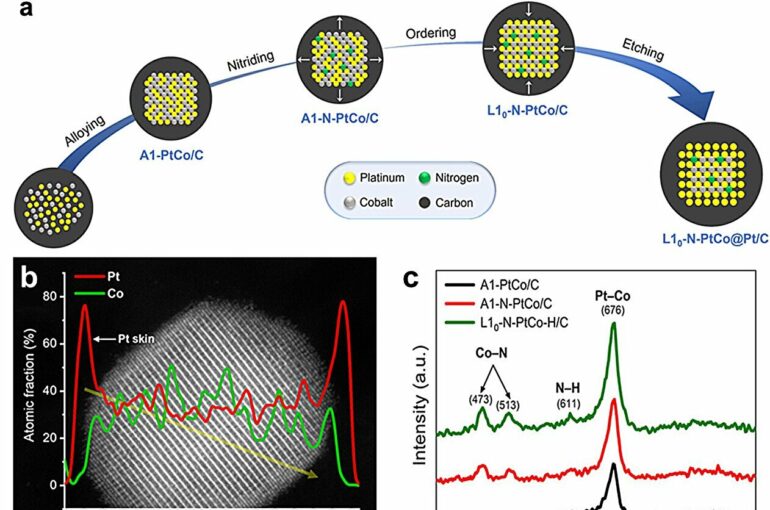A research team has developed a breakthrough technology that dramatically improves the durability of alloy catalysts, a critical component in fuel cells. By incorporating nitrogen into the alloy structure, the team addressed the high cost and low durability of platinum (Pt) catalysts, two major obstacles to commercializing proton exchange membrane fuel cells (PEMFC) for eco-friendly vehicles.
As global efforts to commercialize hydrogen fuel cells intensify, researchers are increasingly focused on overcoming key technical challenges. Among potential solutions, platinum-cobalt (PtCo) alloys have demonstrated exceptional performance but face limitations in long-term use due to their high cost and durability issues, primarily stemming from the easy dissolution of cobalt.
To tackle these challenges, Prof. Jongsung Yu of DGIST’s team developed an innovative synthesis method that integrates nitrogen into PtCo alloys. This nitrogen-doping approach significantly improves the durability of the alloys by stabilizing cobalt through cobalt–nitrogen bonding, effectively preventing its dissolution. This technology not only reduces the amount of platinum required but also maintains high performance and durability, paving the way for the commercialization of low-platinum, high-stability fuel cells.
The work is published in the Journal of the American Chemical Society.
The newly developed nitrogen-doped PtCo alloy is notable for its ordered PtCo structures both on the surface and within the alloy, as well as its exceptional structural stability, which is achieved through cobalt–nitrogen bonding. Computational chemical analyses conducted by Prof. Seoin Baek of Sogang University revealed that this strong cobalt–nitrogen bond increases the dissolution energy of cobalt by approximately twofold, significantly enhancing the stability of cobalt within the alloy.
Additionally, the alloy surpassed the 2025 durability targets set by the U.S. Department of Energy in accelerated durability evaluations, outperforming existing commercial catalysts in both performance and longevity.
“Our research focused on addressing the durability limitations of existing alloys to significantly enhance fuel cell performance,” said Prof. Yu.
“By advancing the application of platinum-cobalt alloys with outstanding initial performance to practical fuel cells, we have developed a technology that meets the demands of both longevity and efficiency for hydrogen fuel cells. We hope this achievement will contribute to making hydrogen fuel cells a sustainable energy solution across various applications, including the automotive, marine, aviation, and power generation sectors.”
More information:
Muhammad Irfansyah Maulana et al, Cobalt Nitride-Implanted PtCo Intermetallic Nanocatalysts for Ultrahigh Fuel Cell Cathode Performance, Journal of the American Chemical Society (2024). DOI: 10.1021/jacs.4c09514
Provided by
Daegu Gyeongbuk Institute of Science and Technology
Citation:
Nitrogen-doped catalyst technology could accelerate hydrogen fuel cell commercialization (2024, December 5)



